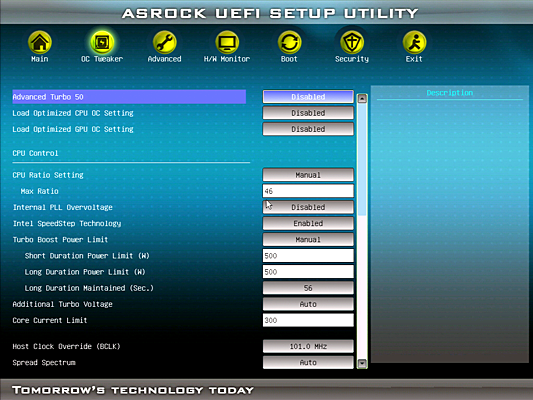BIOS AND OVERCLOCKING
As we can see, ASRock have done a terrific job with their UEFI (Unified Extensible Firmware Interface) BIOS. As stated, it looks much more prettier and easier to grasp a hold of than the traditional, bland BIOS screen:
Novice overclockers can choose from a veriety of ASRock overclocking fail-safe profiles, which are listed in 200 MHz increments. Also, aside from XMP (Extreme Memory Profile), there is also a neat little ‘Advanced Turbo 50’ option that provides an instantaneous 50% overclock. This is more beneficial to older processors, as newer CPU’s generally come clocked at speeds extremely close to the safe-CPU BCLK limit:
Since ASRock have done such a great job with their UEFI BIOS, it is not surprising that they do an equally well done refinement of their utilities:
ASRock have taken their overclocking tool (OCTuner), Intelligent Energy Saver (IES), added a few more utlities, and gave birth to their Extreme Tuning Utility (XTU):
Above, we see the in-depth fan settings, and below, the IES service in action:
 Finally, among other things, the overclocking panel:
Finally, among other things, the overclocking panel:
With everything said and done, tweaked and configured, I managed to hit a staggering 5.02 GHz with little-to-no effort, an excellent result for a well-manfactured motherboard:
Overall, the BIOS is exquisite. It is well laid-out, very clean, and similar settings are grouped together to streamline the submenus.
Personally, my favourite addition to the UEFI BIOS is the use of a mouse for navigation. It seems like such a simple add-on, but considering how in the past (and somewhat still in the future), users were/are limited to using the keyboard and tab key, the inclusion of a critical piece of hardware that is essential in every-day computing seems like a no-brainer. Kudos to ASRock for making such an easy to use BIOS platform.
NEXT: Final Words and Conclusion
INDEX
Page 1: Introduction
Page 2: Specifications, Overview, and Features
Page 3: Closer Look, Specifications, and Benchmark Testing Platform
Page 4: CPU Benchmarks
Page 5: Computation and Productivity Benchmarks
Page 6: Storage and Peripheral Benchmarks
Page 7: Memory Benchmarks
Page 8: Gaming Benchmarks
Page 9: Overall System Benchmarks
Page 10: Z68 Chipset-Specific Benchmarks
Page 11: Temperature, Power, and Efficiency
Page 12: BIOS and Overclocking
Page 13: Final Words and Conclusion
 The SSD Review The Worlds Dedicated SSD Education and Review Resource |
The SSD Review The Worlds Dedicated SSD Education and Review Resource | 
